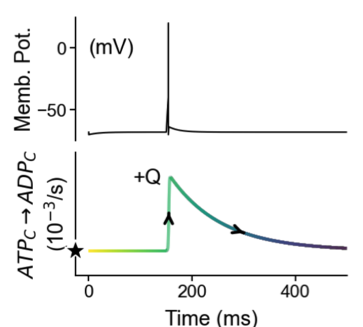
Dear #neurotwitter, we dropped this onto @biorxiv_neursci for your perusal. It's an unusual piece from my lab & I really, really enjoyed working on it with @chc1987. Here it is: Metabolically spikes serve neuronal energy homeostasis (and protect neurons). doi.org/10.1101/2022.1… 

"Metabolic Spikes" is a modelling study on the origins of "spontaneous" activity in neural systems. That sort of baseline activity is ubiquitous! As a field, we accept it's there & include it in models, but why do neurons do that? Fire in the absence of input? Seems kinda weird.
More formally speaking, non-causal spiking contradicts the notion that spikes should be used for coding, and what's more, such "null spikes" seem like a waste of energy. Sort of like opening a window in an NYC apartment in the middle of winter....
https://twitter.com/TPVogels/status/1580878118155210754?s=20&t=aNFrFdh5AxCuJPrOljnc3Q
We argue, YASS, they are a waste of energy, but not insensibly so. To grok this, we need to take a dive into undergrad biochemistry, so hold on tight ( actually don't worry, it's easy:) Welcome to the wonderful world of #mitochondria, the power house of the cell. 

Mitos make ATP & it's rather fascinating, but for us it came down to one thing: When mitochondria make ATP, they also make #free_radicals. That's bad bad bad! Worse, this relationship is non-monotonic! More ATP, more reactive oxygens (ROS). Less ATP, more ROS, too! Seems #toxic! 

Especially given that it's not easy for a neuron to guess how much ATP it's gonna need. Some neurons can use more than 50% of their energy budget on input and output processing, and both can fluctuate wildly! And because thinking is sorta important, neurons can't just chill.
They must be ready for action, but we think that when they don't use up their ATP budget, they will quickly start poisoning themselves! Wouldn't it be nice if the cell could just, I dunno, waste a bunch of ATP? Enter the #metabolic_spike! 

Here, we propose that a neuron senses its metabolic state (+toxic byproducts) & adjusts its activity accordingly. When it's low on ATP, it hits the brakes, when it's high, it spikes; all by way of your friendly neighbourhood metabolically-sensitive #ion_channels. That's the story 

But that's not all folks! We have a bunch of quirky & interesting consequences of metabolic spikes, knock-on effects, what-ifs, experimental predictions & we take a look at where spontaneous activity is super important, the dopamine system. What if metabolic spikes broke😱? 

Read the paper, doi.org/10.1101/2022.1… or stay tuned for more, later right here on this thread in #technicolor.
And here is part two of the series:
https://twitter.com/TPVogels/status/1582686385701801985?s=20&t=KsEMJgF9_jPWfEI7o4AojQ
• • •
Missing some Tweet in this thread? You can try to
force a refresh







